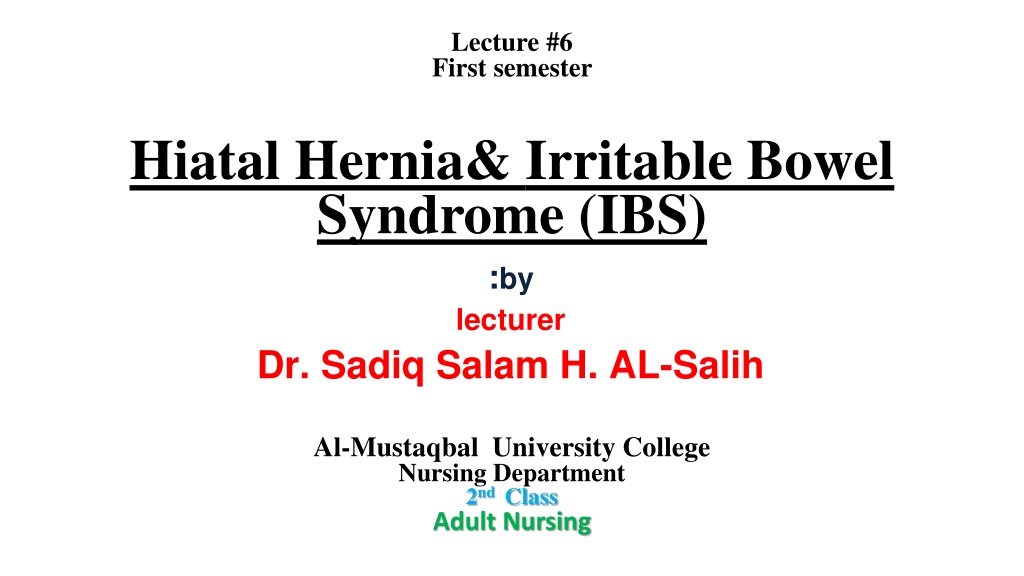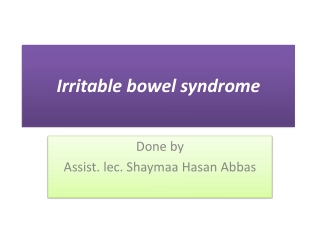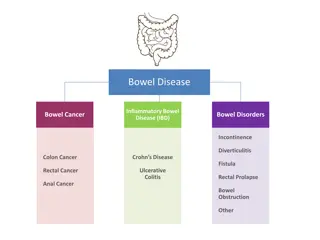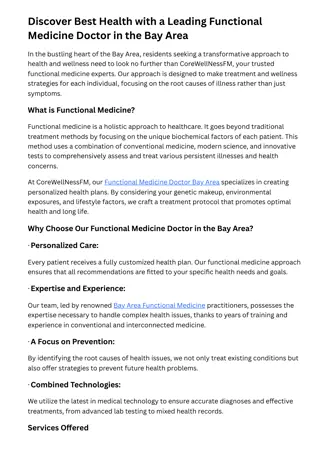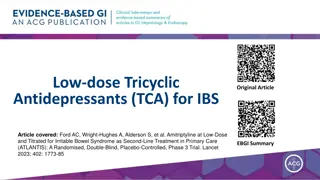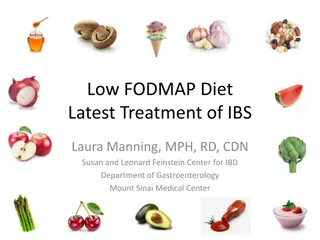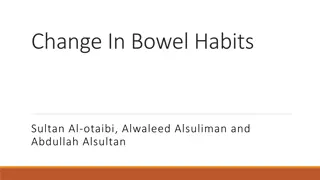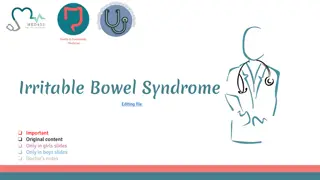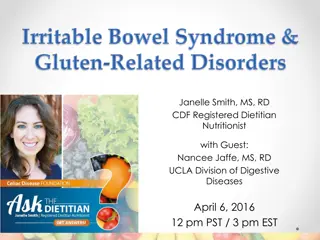Understanding Hiatal Hernia and Irritable Bowel Syndrome (IBS) for Adult Nursing
A hiatal hernia involves the protrusion of the stomach through the diaphragm, leading to various types and complications. Symptoms may include heartburn and dysphagia, diagnosed through barium studies and endoscopic exams. Management includes lifestyle changes, medication, and surgical repair. Nursing interventions focus on educating patients on reflux prevention strategies and when to seek medical help promptly.
Download Presentation

Please find below an Image/Link to download the presentation.
The content on the website is provided AS IS for your information and personal use only. It may not be sold, licensed, or shared on other websites without obtaining consent from the author. Download presentation by click this link. If you encounter any issues during the download, it is possible that the publisher has removed the file from their server.
E N D
Presentation Transcript
Lecture #6 First semester Hiatal Hernia& Irritable Bowel Syndrome (IBS) :by lecturer Dr. Sadiq Salam H. AL-Salih Al-Mustaqbal University College Nursing Department 2nd Class Adult Nursing
Definition: A hiatal hernia is a protrusion of a portion of the stomach through the hiatus of the diaphragm and into the thoracic cavity. Types of hiatal hernias :There are two 1. Sliding hernia the stomach and gastro-esophageal junction slip up into the chest (most common .( 2. Paraesophageal hernia (rolling hernia) part of the greater curvature of the stomach rolls through the diaphragmatic defect.
Pathophysiology/Etiology Muscle weakening due to aging or other conditions, such as esophageal carcinoma. Trauma or following certain surgical procedures . Excessive intra-abdominal by; obesity, pregnancy, abdominal tumors, ascites, and repeated heavy lifting or strain Long term bed rest in a reclining position Complications 1. Incarceration of the portion of the stomach in the chest constricts the blood supply 2. Esophagitis. 3. Barrettsesophagus: is apre-malignant condition in which the normal squamous lining of the lower esophagus is replaced by columnar mucosa (columnar lined esophagus)containing areas of intestinal metaplasia. It occurs as adaptive.
Clinical Manifestations 1. May be asymptomatic 2. Heartburn (with or without regurgitation of gastric contents into the mouth). 3. Dysphagia; chest pain Diagnostic Evaluation 1. Barium study of the esophagus outlines hernia . 2. Endoscopic examination visualizes defect .
Management 1.Elevation of head of bed (15 20 cm [6 8 in]) to reduce nighttime reflux . 2.Antacid therapy to neutralize gastric acid . 3.Histamine-2 receptor antagonist (cimetidine, ranitidine) if patient has esophagitis . 4.Surgical repair of hernia if symptoms are severe. A. Fundoplication: Strengthens the lower esophageal sphincter by suturing the funds of the stomach around the esophagus and anchoring it below the diaphragm. B.Angelchik Prosthesis: Is placement of a C shaped silicon device which is tied around the distal esophagus , anchoring it below the diaphragm .
Nursing Interventions/ Patient Education Instruct patient on the prevention of reflux of gastric contents into esophagus by : Eating smaller meals . Avoiding stimulation of gastric secretions by omitting caffeine and alcohol . Refraining from smoking . Avoiding fatty foods promote reflux and delay gastric emptying . Refraining from lying down for at least 1 hour after meals . Losing weight, if obese . Avoiding bending from the waist and/or wearing tight-fitting clothes or lifting heavy objects. Advice patient to report to health care facility immediately for the onset of acute chest pain may indicate incarceration of a large paraesophageal hernia .
Irritable Bowel Syndrome (IBS) Colon is the part of the large intestine , the last portion of the human gastrointestinal tractis approximately 5 to 5.5 feet long with a diameter of about 2.5 inches, is locatedbetween the cecum and rectum. It isdivided into four sections ascending, transverse descending and sigmoid colon. The organ for storing waste products by form of stool. Reabsorbing water from wastes and maintaining water balance in the body. Serves at the site for the growth of beneficial bacteria and other microorganisms elimination of toxic waste material in the
Definition Irritable bowel syndrome (IBS) Is a chronic functional disorder characterized by recurrent abdominal pain associated with disordered bowel movements, which may include diarrhea, constipation, or both.
Associated factors A complex interplay of (genetic, environmental, and psychosocial factors) are thought to be associated with the onset of IBS. It is believed that some triggers can either herald the initial onset of IBS or exacerbate symptoms in those with diagnosed IBS; these may include chronic stress, sleep deprivation, surgery, infections, diverticulitis, and some foods (e.g. milk, yeast products, eggs, wheat products, red meat). The diagnosis of IBS is made after tests confirm the absence of structural or other disorders.
Pathophysiology IBS results from a functional disorder of intestinal motility. The change in motility may be related to neuroendocrine dysregulation, especially changes in serotonin signaling, infection, irritation, or a vascular or metabolic disturbance. The peristaltic waves are affected at specific segments of the intestine and in the intensity with which they propel the fecal matter forward. There is no evidence of inflammation or tissue changes in the intestinal mucosa.
Clinical Manifestations Symptoms can vary widely, ranging in intensity and duration from mild and infrequent to severe and continuous. The main symptom is an alteration in bowel patterns: constipation (classified as IBS- C), diarrhea (classified as IBS-D), or a combination of both (classified as IBS-M for mixed ). The few patients with IBS who do not fit any of these three categories of IBS-C, IBS-D, or IBS-M, are classified as IBS-U for unknown . Pain, bloating, and abdominal distention often accompany changes in bowel pattern . The abdominal pain is sometimes precipitated by eating and is frequently relieved by defecation. IBS frequently occurs accompanied with other GI disorders, including gastroesophageal reflux disease (GERD), and with a variety of non-GI functional disorders, including chronic fatigue syndrome, chronic pelvic pain, fibromyalgia, interstitial cystitis, migraine headaches, anxiety, and depression.
Assessment and Diagnostic Findings The clinical manifestations of IBS must be present sometime during the last 3 months with onset for at least 6 months prior to diagnosis. These manifestations include recurrent abdominal pain for at least one day weekly that is associated with 2 or more of the following Abdominal pain related to defecation; Abdominal pain associated with a change in frequency of stool; Abdominal pain associated with a change in form /appearance of stool.
Medical Management The goals of treatment are to relieve abdominal pain and control diarrhea or constipation. Lifestyle modification, including stress reduction, ensuring adequate sleep, and instituting an exercise regimen, can result in symptom improvement. The introduction of soluble fiber (e.g., psyllium) to the diet is important to IBS management. Restriction and then gradual reintroduction of foods that are possibly irritating may help determine what types of food are acting as irritants (e.g., beans, caffeinated products, corn, wheat, dairy lactose, fried foods, alcohol, spicy foods, aspartame). For patients with IBS-D, antidiarrheal agents (e.g., loperamide) may be given to control the diarrhea and fecal urgency.
Cont. Patients with all types of IBS complain of abdominal pain, this symptom may be mitigated by prescribing smooth muscle antispasmodic agents (e.g., dicyclomine [Bentyl]). Antidepressants may affect serotonin levels, thus modulating intestinal transit time and improving abdominal comfort. Peppermint oil, a complementary medication, has proven effective in diminishing abdominal discomfort. Other alternatives for IBS management include probiotics. Probiotics are bacteria that include Lactobacillus and Bifidobacterium that can be given to help decrease abdominal bloating.
Nursing Management The nurse s role is to provide patient and family education. The nurse emphasizes and reinforces good dietary habits (e.g., avoidance of food triggers). A good way to identify problem foods is to keep a 1- to 2-week food diary. Patients are encouraged to eat at regular times and to chew food slowly and thoroughly. They should understand that although adequate fluid intake is necessary, fluid should not be taken with meals because this results in abdominal distention. Alcohol use and cigarette smoking are discouraged. Stress management via relaxation techniques, cognitive-behavioral therapy, yoga, and exercise can be recommended
